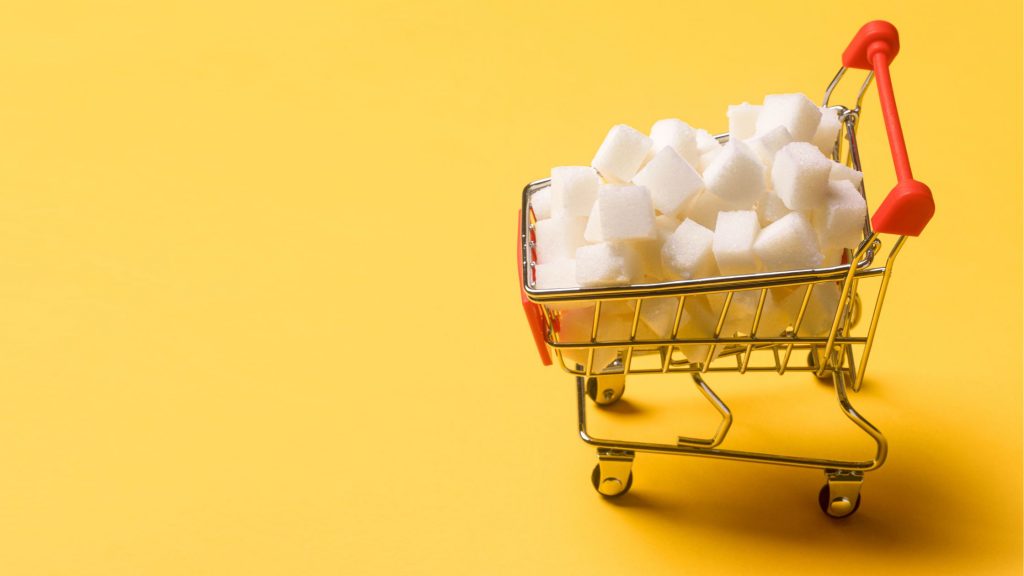Once you have read this blog, you will know how to understand food labels to support weight loss and increase your energy and how to spot a sugar spike in packaged food.
Food marketing is clever and very loosely regulated. For sure, if a food will affect your blood sugar balance with a spike in blood glucose and high insulin release, the food package will not warn you.
It is, in fact, very likely that the food packaging distracts you with “healthy” claims such as lower cholesterol, reduced fat, gluten-free, natural, etc. And the sad truth is none of those means that that food is healthy for you.
To understand if a particular type of packaged food is going to affect your blood sugar balance, you need to become a food label detective!

Why reading and understanding the label is important for your weight loss and energy goals (… and much more!)
First, let me recap what a sugar spike is and why we need to avoid it! When the sugar content in the food you eat (packaged or not) is very high and gets released very quickly in the bloodstream, this is not good news. It is not good news for your body or health and certainly not great for your waistline and energy.
Constant and frequent imbalanced blood sugar leads to high insulin secretion, insulin resistance and eventually, in the long term, to DT2. It also causes inflammation, low immunity and weight gain! Also, going up and down like a yo-yo in blood glucose means that your energy is poorly regulated, and so are your moods and concentration.
Keeping balanced blood sugar is a must for many health reasons, and we cannot ignore it! When it comes to shopping for your foods, you must pay particular attention to refined, processed and packaged food …basically anything that comes with a label needs to be carefully evaluated.
This is how to understand if that food gets the green light and ends up in your trolley or the red light, and you throw it back onto the shelf!
The four steps to spot a blood sugar spike on a food packaging:
#1 Look at the ingredient list
The ingredients are listed in descending order by weight. If sugar is in the top 5 on the list, that means there is a considerable amount of sugar in that food, even if it is savoury. For example, a bottle of ketchup or some sliced bread. If sugar is in the top 5 ingredients…graciously or not, return that food to the shelf.

#2 Check for the many names of sugar
Yes, sugar has many disguises, and it can be listed under the following types of sugars:
Agave nectar, agave syrup, barley malt, beet sugar, brown rice syrup, brown sugar, cane juice crystals, cane sugar, caramel, coconut sugar, icing sugar, corn syrup, corn syrup solids, crushed fruit, date sugar, dextrin, dextrose, evaporated cane juice, fructose, fruit juice, fruit juice concentrate, fruit pure concentrate, galactose, glucose, glucose syrup solids, golden sugar, golden syrup, grape sugar, HFCS high fructose corn syrup, honey, icing sugar, malt syrup, maltodextrin, maltose, maple syrup, muscovado sugar, panela sugar, pressed fruit, raw sugar, rice syrup, sucrose, and sugar!

#3 Check the Nutrition Facts
Ignore the calorie content; yes, you have read it right! The type of macronutrients and their ratios are more important than the calories in that food.
Let me explain.
The blood-sugar spikes with all their negative consequences are determined by the number of carbohydrates and sugar that packaged food contains and their ratio in relation to the fibre content, NOT by the number of calories of that food.
The most important numbers to look at here are the number of carbs and sugar per 100g of product. The higher those numbers, the higher the sugar spikes. Fibre is the only type of carbohydrate that your body does not break down; therefore, it does not affect your blood sugar levels. The higher the amount of fibre in the food, the flatter the blood sugar curve, and this is what we want: a nice, flat and balanced sugar release.
Choose foods that get close to 1g of fibre for 5 grams of carbs.
This is how to calculate that: look for the Total Carbohydrates and divide that number by 5. Look for foods that contain the nearest amount of fibre to that number for 100g of product; I warn you! This is not that easy as processed, refined and packaged food is often stripped of its fibre!
For example, I am looking at a pack of gluten-free pasta. The total amount of carbs for 100g is 36g. Thirty-six dived by five equals 7.2g of fiber. Now, I check the amount of fibre in the Nutrition Facts, which is 3.3g.
Since that fibre amount is not even half the preferable amount (7.2g), I would look for another type of pasta, which gives me a number nearer to my ratio. Or, if I decide to use this pasta, I will dress it very well with plenty of delicious ragu’, which is rich in protein from the minced beef meat and more fibre from the celery, tomatoes, and mushrooms I use to make it.
And this brings me to the next point.

#4 Dress your packaged food
If you still decide to buy packaged food that does not tick the points described above, make sure that before you consume it, you dress it up!
Combine that food with extra fibre, protein and some healthy fats so that when you eat that combo of ingredients, the carbs get digested less quickly, and the release of sugars is gentler.
For example, if you fancy a crumpet, make sure that you add some organic butter to it and top it up, not with jam (which is more sugar) but with some peanut butter or some mushed avocado (protein and fat).
Click HERE for the PDF with the list of the various names of sugar and the calculation to understand if that package of food is likely to spike your blood sugar.
Please share this blog with any friends, family member, or colleague who, like you, wants to take charge of their health and energy. I would really appreciate it if you invited them to join our community of fab ladies!
With love, energy and care
Monica x





0 Comments